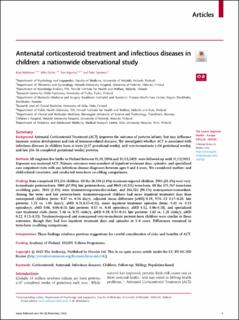| dc.description.abstract | Background
Antenatal Corticosteroid Treatment (ACT) improves the outcome of preterm infants, but may influence immune system development and risk of immune-related diseases. We investigated whether ACT is associated with infectious diseases in children born at term (≥37 gestational weeks), and very-to-moderate (<34 gestational weeks), and late (34–36 completed gestational weeks) preterm.
Methods
All singleton live births in Finland between 01/01/2006 and 31/12/2021, were followed-up until 31/12/2021. Exposure was maternal ACT. Primary outcomes were numbers of inpatient treatment days, episodes, and specialized care outpatient visits with any infectious disease diagnoses between ages 0 and 4 years. We considered mother- and child-related covariates, and conducted term-born co-sibling comparisons.
Findings
Data comprised 855,234 children. Of the 20,858 (2.4%) treatment-exposed children, 5981 (28.2%) were very-to-moderate preterm-born, 5809 (27.9%) late preterm-born, and 9069 (43.5%) term-born. Of the 271,767 term-born co-sibling pairs, 5010 (1.8%) were treatment-exposure-discordant, and 266,522 (98.1%) nonexposure-concordant. Among the term- and late preterm-born, treatment-exposed children had more inpatient treatment days than nonexposed children (term: 0.87 vs. 0.56 day/y, adjusted mean difference [aMD] 0.19, 95% CI 0.17–0.28; late preterm: 1.35 vs. 1.00 days/y, aMD 0.31,0.13–0.31), more inpatient treatment episodes (term: 0.43 vs. 0.33 episodes/y, aMD 0.06, 0.06–0.11; late preterm: 0.55 vs. 0.48 episodes/y, aMD 0.12, 0.06–0.18), and specialized care treatment visits (term: 1.46 vs. 0.95 visits/y, aMD 0.38; 0.34–0.43; late preterm: 1.63 vs. 1.28 visits/y, aMD 0.22, 0.12–0.32). Treatment-exposed and nonexposed very-to-moderate preterm-born children were similar in these outcomes, though they had less inpatient treatment days and episodes at 3–4 years. Differences remained in term-born co-sibling comparisons.
Interpretation
These findings reinforce previous suggestions for careful consideration of risks and benefits of ACT. | en_US |

